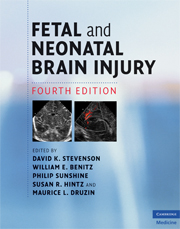Book contents
- Frontmatter
- Contents
- List of contributors
- Foreword
- Preface
- Section 1 Epidemiology, pathophysiology, and pathogenesis of fetal and neonatal brain injury
- Section 2 Pregnancy, labor, and delivery complications causing brain injury
- Section 3 Diagnosis of the infant with brain injury
- Section 4 Specific conditions associated with fetal and neonatal brain injury
- 22 Congenital malformations of the brain
- 23 Neurogenetic disorders of the brain
- 24 Hemorrhagic lesions of the central nervous system
- 25 Neonatal stroke
- 26 Hypoglycemia in the neonate
- 27 Hyperbilirubinemia and kernicterus
- 28 Polycythemia and fetal–maternal bleeding
- 29 Hydrops fetalis
- 30 Bacterial sepsis in the neonate
- 31 Neonatal bacterial meningitis
- 32 Neurological sequelae of congenital perinatal infection
- 33 Perinatal human immunodeficiency virus infection
- 34 Inborn errors of metabolism with features of hypoxic–ischemic encephalopathy
- 35 Acidosis and alkalosis
- 36 Meconium staining and the meconium aspiration syndrome
- 37 Persistent pulmonary hypertension of the newborn
- 38 Pediatric cardiac surgery: relevance to fetal and neonatal brain injury
- Section 5 Management of the depressed or neurologically dysfunctional neonate
- Section 6 Assessing outcome of the brain-injured infant
- Index
- Plate section
- References
33 - Perinatal human immunodeficiency virus infection
from Section 4 - Specific conditions associated with fetal and neonatal brain injury
Published online by Cambridge University Press: 12 January 2010
- Frontmatter
- Contents
- List of contributors
- Foreword
- Preface
- Section 1 Epidemiology, pathophysiology, and pathogenesis of fetal and neonatal brain injury
- Section 2 Pregnancy, labor, and delivery complications causing brain injury
- Section 3 Diagnosis of the infant with brain injury
- Section 4 Specific conditions associated with fetal and neonatal brain injury
- 22 Congenital malformations of the brain
- 23 Neurogenetic disorders of the brain
- 24 Hemorrhagic lesions of the central nervous system
- 25 Neonatal stroke
- 26 Hypoglycemia in the neonate
- 27 Hyperbilirubinemia and kernicterus
- 28 Polycythemia and fetal–maternal bleeding
- 29 Hydrops fetalis
- 30 Bacterial sepsis in the neonate
- 31 Neonatal bacterial meningitis
- 32 Neurological sequelae of congenital perinatal infection
- 33 Perinatal human immunodeficiency virus infection
- 34 Inborn errors of metabolism with features of hypoxic–ischemic encephalopathy
- 35 Acidosis and alkalosis
- 36 Meconium staining and the meconium aspiration syndrome
- 37 Persistent pulmonary hypertension of the newborn
- 38 Pediatric cardiac surgery: relevance to fetal and neonatal brain injury
- Section 5 Management of the depressed or neurologically dysfunctional neonate
- Section 6 Assessing outcome of the brain-injured infant
- Index
- Plate section
- References
Summary
Introduction
Since the initial description of acquired immune deficiency syndrome (AIDS) cases in infants and children more than 25 years ago, the epidemiology of the pediatric human immunodeficiency virus type 1 (HIV-1) epidemic has changed significantly. Most pediatric HIV infections occur through perinatal transmission. Dramatic declines in the number of perinatally HIV infected children have been reported in the USA and Europe due to prompt implementation of strategies to prevent mother-to-child transmission of HIV (PMTCT). Further, availability of highly active antiretroviral therapy (HAART) has led to improved survival of HIV-infected children into adolescence and adulthood, changing most HIV infections into a chronic rather than an acute disease. In contrast, prevention of mother-to-child HIV transmission is a major public health challenge in many resource-limited countries. Although several effective, simple, and less expensive prophylactic antiretroviral regimens are available to prevent perinatal HIV transmission, these interventions have not been widely implemented in the developing world.
Pediatricians and obstetricians play a crucial role in the prevention of perinatal HIV transmission, including identification of HIV-infected women during pregnancy, treatment of the pregnant women with appropriate antiretroviral therapy, ensuring evaluation for HIV infection in early infancy, and subsequent provision of ongoing care for children and families affected by HIV. The purpose of this chapter is to review advances in the prevention of perinatal HIV transmission and highlight certain unique features of HIV infection in infants with a focus on early diagnosis, clinical manifestations, treatment, and prognosis.
- Type
- Chapter
- Information
- Fetal and Neonatal Brain Injury , pp. 378 - 388Publisher: Cambridge University PressPrint publication year: 2009



